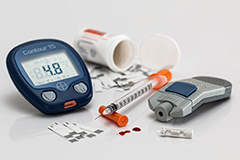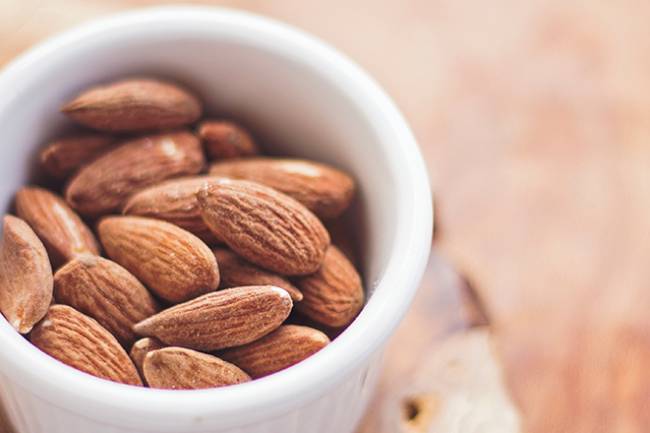How to Reverse Type 2 Diabetes

It is estimated that 415 million people worldwide are living with diabetes, which is 1 in 12 of the world's adult population.
Even more alarming is that this figure has been predicted to rise to 642 million by 2040. However, this doesn't have to be the case. Once it was thought that diabetes was a progressive disease that could only be slowed down.
But now there is emerging research that has outlined powerful ways of managing type 2 diabetes and even putting this disease into remission.
What Is Type 2 Diabetes?
Type 2 diabetes mellitus (T2DM) is a condition that represents chronically high blood sugar, and is thought to represent 90% of diabetes sufferers.
To understand the aetiology of T2DM, we have to first touch on the hormone insulin. Insulin is produced by the beta cells of the islets of Langerhans in the pancreas, with its main role in the body being the regulation of glucose (sugar) in the blood.
T2DM occurs when either the pancreatic beta cells cannot produce enough insulin to regulate the high dietary intake of sugar, or the body's cells become resistant to insulin, a phenomenon known as insulin resistance.
The body has the capacity to store glucose as glycogen, which mainly happens in the muscles (around 400g for the average adult), but it can also be stored in the liver at amounts of around 100g. In a healthy individual who is ‘insulin sensitive', the pancreas will release insulin after a carbohydrate-containing meal elevates blood sugar.
Insulin will signal the body's cells to accept the glucose, which subsequently provides the cells with energy and reduces the sugar in the blood. To effectively shuttle glucose into the cells to be stored as glycogen, insulin binds to insulin receptors near the cells membrane, which stimulates a chain reaction.
At the end of this reaction, proteins known as glucose transporter 4 (GLUT4) will migrate to the cell membranes, and transport sugar from the blood into the cells. When inside of the cell it can either be used for creating energy immediately or stored as glycogen for later use.
However, in someone with insulin resistance, the insulin will not be able to effectively bind to the insulin receptors, meaning no chain reaction and no migration of GLUT4.
This results in glucose staying in the blood at dangerously high levels (hyperglycemia), which over time can lead to serious health issues. These will be explored later in the article.
What Are the Symptoms of Type 2 Diabetes?
It is thought that over half a million people in the UK are living with diabetes but don't yet know it; so it is important to look out for the symptoms. This is even more important if you are overweight or obese, which 80% of type 2 diabetics are. Similarly, if you have a family history of T2DM it is very important to adopt a healthy lifestyle and have regular check-ups with your doctor. The typical symptoms of diabetes are:
- Passing urine more regularly, especially during the night – The body tries to get rid of excess sugar in the urine.
- Increased thirst – To stimulate the production of urine.
- Lethargy – Caused when the glucose isn't getting into the cells to provide energy.
- Weight loss and loss of muscle mass – Insulin has an anti-catabolic effect, meaning that it helps to prevent muscle breakdown. Diabetics therefore can have an increased rate of muscle loss.
- Impaired vision – High levels of blood sugar cause the lens of the eye to swell, which could lead to potential damage.
Other symptoms include increased excessive hunger, headaches, slow healing of wounds, itching, frequent yeast infections, tingling in the hands and feet, and sexual dysfunction. If you have any of these symptoms it is highly advisable that you see your GP.
How Is Type 2 Diabetes Diagnosed?
There are numerous ways that someone can be diagnosed as having an impaired glucose tolerance (pre-diabetes) or as being type 2 diabetic. Firstly, there can be a simple blood test to indicate fasting glucose levels usually taken following 8-12 hours of no food.
For someone without diabetes, a fasting blood sugar of <6 mmol/L would be expected. For someone with pre-diabetes, a value of 6-7mmol/L would be seen, whereas someone with diabetes would have a fasting blood sugar level of >7 mmol/L.
A doctor can also perform what is known as an oral glucose tolerance test, to show how the body handles a carbohydrate load. Usually, the participant will arrive fasted and then have their blood sugar taken. Once a baseline value is obtained, the participant will consume a beverage that contains 75g of glucose.
Over the next two hours, blood sugar readings will be obtained regularly to track the body's response. After two hours a value of <7.8 mmol/L indicates you are not diabetic, a value of 7.9-11 mmol/L shows pre-diabetes, whereas a value over 11 mmol/L indicates diabetes.
Last but not least, a reading for something called glycated haemoglobin, or HbA1c, can be taken by a medical professional. HbA1c is widely regarded as the gold standard measurement of diabetes, because it provides an average blood glucose reading from the last 2 to 3 months.
An HbA1c of 6.5% or above indicates diabetes, whereas a reading of 6-6.4% indicates pre-diabetes. This reading is regularly taken in diabetics as an objective way to indicate how successful their current treatment is.
What Are the Health Implications of Type 2 Diabetes?
The health consequences of uncontrolled diabetes can be devastating. Here are some of the most common health implications:
Heart Disease
Unfortunately, diabetics are much more likely to suffer from heart issues. A 2007 diabetes UK report indicated that diabetic middle aged men are 5 times more likely to suffer from cardiovascular disease, with women 8 times more likely.
The risk is massively increased because high blood sugar leads to the damage of blood vessels, and the nerves which control the heart and vasculature. This deterioration can lead to events such as heart attacks or strokes, which are the leading causes of death in diabetics.
Kidney Disease
In diabetics, kidney disease is known as diabetic nephropathy. Research has yet to elucidate the exact reason why 40% of diabetics develop nephropathy, but is likely due to high blood sugars impact on the blood vessels and the kidneys role in blood filtration. High blood pressure, which is all too common in type 2 diabetics, is also known to accelerate the progression of nephropathy.
Blindness
Diabetic retinopathy is the most common eye disease in sufferers of diabetes. This condition occurs due to pathologies to the retinal blood vessels or a swelling of these vessels known as macular oedema. In more serious cases blood vessels can actually grow on the surface of the retina, which can lead to blindness. It is thought that almost 1500 people a year in England alone completely lose their sight due to diabetic retinopathy.
Neuropathy
Neuropathy is a disorder that affects the nervous system, and can be categorised as sensory, motor and autonomic neuropathy. Sensory neuropathy affects the nerves which detect touch and temperature, motor neuropathy affects movement whereas autonomic neuropathy affects involuntary actions such as heart rate and digestion.
Neuropathy is thought to affect 50% of diabetics and can lead to further issues such as gastrointestinal complaints, urinary problems, impotence, muscle weakness and wastage of tissue in the hands and feet. Because of the decline in motor function and circulatory problems, diabetes can sometimes lead to amputation, which is most commonly seen in the lower limbs. NHS statistics show that diabetics are 15 times more likely to undergo amputations.
Cognitive Decline
The brain was once thought to be insulin-independent, but now research has shown that insulin plays an important role within the organ. Insulin is thought to control food intake and regulate cognitive functions, particularly memory. Evidence is starting to suggest that insulin resistance in the brain can lead to cognitive decline and the development of dementia.
Muscle Loss
Muscular atrophy may seem like quite a benign symptom of diabetes when compared to the others, but this is anything but the case. Healthy muscles are needed to help perform physical activity and exercise. Muscles also have a relatively large capacity to store glucose as glycogen, meaning more sugar can leave the blood.
Muscles also have a high metabolic activity, meaning they burn lots of calories per day. So, a loss of muscle means our bodies burn fewer calories and therefore gain weight. Further insulin resistance and the associated health complications can then become all the more apparent. A total downward spiral.
The key to preventing the development of these serious conditions is to take control of diabetes early and be consistent with the positive lifestyle changes that we shall explore below.
How Can Type 2 Diabetes Be Managed or Even Reversed?
Now we have covered the prevalence, cause, symptoms, diagnosis and health complications of T2DM, it is time to look at what positive lifestyle changes can be made to manage, or in some cases even reverse this disease.
Very Low Energy Diets (VLED)
 One of the landmark studies indicating the power of nutrition in relation to diabetes control/reversal was conducted by researchers from the University of Newcastle in 2011. This study recruited 11 obese, type 2 diabetics for an 8 week period. In this study, the participants were put on a semi-starvation diet, which consisted of 600kcal per day. 500kcals came from a beverage which contained carbohydrates, protein, fat, vitamins and minerals, with the final 100kcals coming from three portions of fibrous vegetables.
One of the landmark studies indicating the power of nutrition in relation to diabetes control/reversal was conducted by researchers from the University of Newcastle in 2011. This study recruited 11 obese, type 2 diabetics for an 8 week period. In this study, the participants were put on a semi-starvation diet, which consisted of 600kcal per day. 500kcals came from a beverage which contained carbohydrates, protein, fat, vitamins and minerals, with the final 100kcals coming from three portions of fibrous vegetables.
The participants also drank at least 2 litres of water per day. The results of this study were nothing short of astounding. After 8 weeks, the participants on average lost over 15kg of bodyweight, going from 103kg to 88kg, maintained most of their lean mass, decreased HbA1c from 7.4% to 6%, decreased pancreas and liver fat and normalised triglyceride levels.
Furthermore, pancreatic beta cell function normalised, meaning sufficient insulin could now be produced. There was also the return of insulin sensitivity in the liver. Bear in mind that some of these participants had suffered from diabetes for up to 4 years.
This evidence shows that years, or maybe even decades, of poor lifestyle choices leading to diabetes and certain aspects of metabolic syndrome could be reversed in as little as 2 months through nutrition alone.
How Does a Very Low Energy Diet Help Diabetes?
How did the participants survive and function normally on such a low calorie diet? The answer is to do with a change of fuel usage.
The human body can be likened to a hybrid engine, with the ability to function on multiple fuel sources. By manipulating our diets, we can obtain our fuel through different energy pathways. As we found earlier, the average body only contains ~500g of sugar, with most being stored in the muscles and liver as glycogen and around 5g being glucose in the bloodstream.
With each gram of glucose only providing 4 calories, we only have around 2000kcal worth of energy from glucose, which for most of us equates to barely a day's energy supply.
Compare this to fat, which provides 9 calories worth of energy per gram, and can be stored in almost endless amount, meaning most of us have enough fat to fuel us for months or more. Now it should make perfect sense to see why the body has the ability to switch to fat-burning for fuel.
The 600kcal per day diet quickly depleted the body of all glucose, meaning that the body has to almost exclusively use the stored fat for fuel, which is known as a state called ketosis. Ketosis is well-known to decrease appetite sensations drastically even in the presence of a calorie deficit, which is why the participants could maintain the very low calories without caving in to hunger.
Although the body for the most part can run on fat and ketones, which are a by-product of fat burning, we also require a certain amount of glucose, as the brain/central nervous system and muscles during high intensity exercise use a very high proportion of glucose for their fuel. The red blood cells are also solely fuelled by glucose.
So why didn't the lack of glucose in this diet cause the body to shut down? Well, the body has the capacity to make its own glucose, via a process in the liver known as gluconeogenesis – the creation of glucose from non-carbohydrate sources such as amino acids from protein and glycerol. When dietary carbohydrate intake is typically below ~120g per day, the body can make up for this lack of glucose by making its own.
For this reason, there is no such thing as an ‘essential carbohydrate'.
It must be stressed that a VLED is quite an extreme approach that was never designed to be maintained for long periods. It is a powerful tool to massively reduce calories, bodyweight, carbohydrate intake and insulin requirement to improve metabolic health.
This type of diet also appears to give the pancreas and liver time to regenerate itself. The massively impressive results from this kind of diet will be attractive to many diabetics. If you are contemplating this kind of regime, it must be performed under close supervision of medical experts to ensure its safety.
Low Carbohydrate Diets
 Another type of diet, which is more of a long-term solution to diabetes, is a low carbohydrate, high fat diet. Often used for the treatment of medical conditions such as epilepsy and certain types of cancer, these diets have soared in popularity recently for the treatment of diabetes, thanks to a plethora of emerging evidence.
Another type of diet, which is more of a long-term solution to diabetes, is a low carbohydrate, high fat diet. Often used for the treatment of medical conditions such as epilepsy and certain types of cancer, these diets have soared in popularity recently for the treatment of diabetes, thanks to a plethora of emerging evidence.
In theory, this pattern of eating makes perfect sense, as limiting carbohydrates will mean a lower influx of glucose into the blood and subsequently less insulin will be required. Fat also has a minimal impact on insulin secretion.
As we have previously uncovered, the body can quite efficiently run on ketones from fat and make any glucose it requires. Firstly, it is important to define what a low carbohydrate diet is. Although the term is subjective and opinions differ, low carbohydrate diets typically recommend consuming less than 130g per day.
Very low carbohydrate diets (also known as ketogenic diets) recommend consuming less than 30-50g of carbohydrates per day, whereas a moderate carbohydrate intake is seen as around 130-200g daily. The majority of energy will come from fat, both unsaturated and saturated, with a moderate amount from protein.
There are many published studies that have looked at the benefits of carbohydrate-restricted diets, with one of great interest published in Nutrition & Metabolism in 2005. This paper found that in 21 type 2 diabetics, a 16 week restriction of carbohydrates to a goal of less than 20g per day led to massive improvements in metabolic health. On average, the participants' HbA1c decreased from 7.5% to 6.3%, they lost almost 10kg of weight and their triglycerides decreased by 46%. Looking specifically at the HbA1c, this represents the participants going from being diabetic, back to being pre-diabetic.
Finally, 7 participants totally discontinued their diabetes medication, 10 reduced it whereas 4 of the participants were unchanged. In their entirety, these are very impressive results. Limiting, or totally discontinuing diabetes medication is a great benefit for many diabetics, given the common side effects such as gastrointestinal issues, kidney complications and weight-gain.
Furthermore, a study from 2012 that looked at evidence from nearly 10,000 patients showed that metformin – the most widely prescribed T2DM drug - did not improve all-cause mortality, heart disease risk, or the occurrence of heart attacks, strokes, vascular disease or leg amputations. In a similar vein, insulin injections for type 2 diabetes have actually been associated with an increase in diabetes complications, cancer and all-cause mortality. A huge failure of modern medicines it seems.
How Do Carbohydrate Restricted Diets Compare to Low Fat Diets for Diabetics?
How do restricted carbohydrate diets (low or very low) compare with low fat diets – the one that on-the-whole, the NHS and UK dieticians currently recommend for diabetes management?
One of the most recent studies published found that over a 12 month period, a low carbohydrate diet led to superior weight-loss, improvements in HbA1c and reductions in medication usage. The researchers reported that 60% of the participants who received the low carbohydrate treatment discontinued their medication, which is in stark contrast to the zero participants in the low fat group.
Similar impressive findings were seen in another study which was 32 weeks in duration. It was found that a very low carbohydrate diet paired with an online lifestyle support programme led to significant reductions in HbA1c, body weight and triglyceride levels when compared to a low fat diet with the same online support.
Most impressive was that more than half the participants in the low carbohydrate group reduced their HbA1c below 6.5%, with 3 of the participants getting below 6%, showing a remission of diabetes.
This hot topic of conversation was also further assessed recently in a meta-analysis of randomised control trials published last year in the European Journal of Clinical Nutrition. A meta-analysis of randomised control trials is considered the gold standard of scientific evidence, as it uses statistical analytical techniques to collate the results of numerous high-quality studies. The researchers reviewed 18 studies, involving over 2200 participants. They found that a low carbohydrate eating plan led to significant improvements in HbA1c, HDL (‘good') cholesterol, triglycerides, systolic blood pressure and a reduced need for diabetes medication.
The researchers however found no significant difference in weight loss, total cholesterol, LDL (‘bad') cholesterol or diastolic blood pressure. It is surprising that the meta-analysis found no significant improvements in weight loss from carbohydrate restriction, given that many studies show a benefit. Even though carbohydrate-restricted diets appear to be superior, many participants of research studies still seem to do reasonably well on a low fat diet however.
One study which showed this was published in Diabetes Care in 2014. The researchers found that over a 6 month period, a low fat diet was as effective as a low carbohydrate diet for improving weight-loss, blood pressure, fasting blood sugar levels and LDL cholesterol.
Conversely, the low carbohydrate diet was superior in terms of HbA1c, HDL cholesterol, triglycerides, blood sugar variability and medication need. Very similar findings were reported by the same research group the following year. It was found that over a one year period, a high carbohydrate, low fat diet was just as effective as a low carbohydrate diet for decreasing bodyweight, blood pressure, HbA1c, fasting glucose and LDL cholesterol.
However the low carbohydrate diet was again found to be superior for reducing medication needs, blood sugar variability, triglycerides and HDL cholesterol. These results from the above studies show that although a low fat ‘conventional' diet can be useful for improving markers of diabetes and metabolic disease, carbohydrate restricted diets, either low or very low, are in many ways superior. It is of interest to note that in the above studies mentioned, not one variable measured was significantly better in the low fat compared to the low carbohydrate diets.
Why Do Low Carbohydrate Diets Work?
Why is a carbohydrate-restricted diet effective? Firstly, from a weight-loss perspective, these diets almost fully omit one of the 3 macronutrients, which substantially limits food choice and thus calorie intake. As it can be very easy to overeat carbohydrate rich foods, this is certainly a primary factor. Hunger is also an important factor when dieting and is one of the main reasons why people struggle to adhere to a calorie-controlled diet. Unfortunately, when dieting the body increases hunger hormones and decreases the hormones that make us feel full, making the situation all the more difficult.
However, one of the most commonly cited benefits of a low or very low carbohydrate diet is that it increases satiety and makes the diet more sustainable. Research has also shown that over a 24 month period, people on a low carbohydrate diet can maintain a lower calorie intake than those on a low fat diet and thus lose more weight and control their diabetes more effectively. Recent research has also uncovered some fascinating findings when it comes to appetite.
One study published in the International Journal of Obesity found that 8 weeks of a very low carbohydrate diet led to participants losing between 10-17% of their bodyweight, without experiencing unfavourable changes to their appetite hormones. However, once participants increased their calories and carbohydrate intake, their hunger returned which would have likely led to a regain of weight.
A recent meta-analysis has confirmed these findings, as they concluded that very low carbohydrate diets prevent an increase in appetite despite weight-loss. The most fascinating of recent findings was published in October of 2017 and demonstrated that triglycerides (fats in the blood) do cross the blood-brain barrier, which can cause insulin resistance and leptin resistance (an appetite hormone). This can subsequently lead to obesity and diabetes.
As we discussed earlier, one of the most effective ways of decreasing triglyceride levels is by limiting carbohydrate intake. It is therefore plausible that low carbohydrate diets decrease the desire to eat by exerting positive effects on both gut hormone secretion and the brains sensitivity to insulin and appetite signals. It was once hypothesised that a low carbohydrate diet also held an advantage over a low fat diet in terms of metabolism, as people thought it burned more calories.
However, a large scale metabolic ward study conducted in 2015 showed that when protein intake was matched between the diets, there was only a small, non-significant improvement from a low carbohydrate diet with respect to calorie burning.
It is important when studying the effects of a low carbohydrate vs low fat diet to match for protein intake, as increasing protein is well-known to have appetite-blunting effects, to spare muscle mass and to increase metabolic rates. This is because the digestion of protein requires a substantially greater amount of energy when compared to carbohydrates or fat. Many people in free living conditions increase their protein intake on a low carbohydrate diet to compensate for the lack of carbohydrates, which often means they see a big difference in their hunger and bodyweight.
As mentioned earlier, the reason a low carbohydrate diet may improve blood glucose control is straight forward. Unlike carbohydrates, fat intake does not increase blood sugar, which subsequently means no insulin is required. The effects can be quite powerful, as research from 2016 showed that just one day of eating a low carbohydrate diet (30% of overall energy intake vs 60%), can decrease acute insulin resistance by nearly 40%. Given the evidence behind a low carbohydrate way of eating for treating diabetes and obesity, why does there appear to be so much resistance to this method?
Opposition to Low Carbohydrate Diets
 Although the plethora of positive results has stimulated many countries around the world to change their dietary advice for diabetics, the UK in particular still seems to be conservative about adopting a new approach. Published research that interviewed 320 UK registered dieticians found that 48% of them do advise type 2 diabetics to occasionally or frequently restrict carbohydrates.
Although the plethora of positive results has stimulated many countries around the world to change their dietary advice for diabetics, the UK in particular still seems to be conservative about adopting a new approach. Published research that interviewed 320 UK registered dieticians found that 48% of them do advise type 2 diabetics to occasionally or frequently restrict carbohydrates.
However, that means that the other 52% don't recommend carbohydrate restriction to people who are fundamentally intolerant to carbohydrates, despite the evidence into the efficacy of low carbohydrate diets. But why is this case?
The major concern that the NHS and the UK dieticians have is the lack of long term evidence into the safety of low carbohydrate diets. Another commonly cited reason is that low carbohydrate diets can lead to deficiencies in vitamins, minerals and fibre. Any pattern of eating can lead to nutrient deficiencies when not incorporating the right foods.
Eggs, nuts, oily fish, dairy, avocados, dark chocolate and meats are funnily enough some of the most nutrient dense foods you could eat, yet are popular among individuals following a low carbohydrate diet. With a small amount of guidance from qualified dieticians and nutritionists, a vitamin and mineral deficiency would easily be avoided.
The concern about fibre intake is a rational one, given that a significant amount of fibre-containing foods such as wholegrains, legumes, starchy vegetables and certain fruits are typically limited. However, nuts, berries, vegetables, avocados and dark chocolate are all good sources of fibre, and are all encouraged to be regularly eaten on a carbohydrate-restricted diet. The necessity of glucose is also one of the reasons why people are recommended to eat high carbohydrate diets, ensuring there is an influx of glucose multiple times per day.
It is true that certain systems in the body require glucose for fuel, but as we found earlier, the body can efficiently create the glucose it needs through gluconeogenesis. Finally, one argument that is often levied is that low carbohydrate diets are unsustainable in the long term.
There may be some merit to this argument, but sustainability to a diet is far too individualised to make such a blanket statement. From the research, the dropout rate between low carbohydrate and low fat diets is often very similar, showing that all diets are challenging regardless of macronutrient composition.
An important point to stress is that low carbohydrate doesn't have to mean no carbohydrate. Recommendations for the magnitude of carbohydrate restriction should be based on the severity of diabetes and insulin resistance. So for some, a moderate carbohydrate intake would be beneficial, whereas others may need a very low carbohydrate diet to see the most benefit.
The meta-analysis that looked at the benefits of carbohydrate restriction found that less than 50g of carbohydrates per day was difficult for most to sustain, but less than 130g per day was not much of an issue. Furthermore, as low and very low carbohydrate diets have consistently shown to impressively reduce body weight, markers of diabetes and metabolic disease also reduce the need for medication. This pattern of eating is likely to be sustained because it helps people massively improve their health and wellbeing.
Low Carbohydrate Diets in Practice
Now we have looked at the theory and research behind carbohydrate-restricted eating, let's explore how it could look in practice. As earlier mentioned, a typical low-carbohydrate diet is high in fat, both saturated and unsaturated and contrary to popular belief, it is not high in protein. Firstly, certain proteins can stimulate insulin secretion quite significantly, which is not good for diabetics. Secondly, if the body has more protein than it requires, the excess protein will be turned into glucose, meaning less fat burning is required.
On a carbohydrate-restricted diet, all kinds of meat, fish (especially the omega 3 rich oily fish), nuts, seeds, berries, vegetables, avocados, olive oil and full-fat diary will make up the majority of meals. Herbs and spices are also regularly used for their taste and health benefits. As you can see this style of eating focuses on nutrient-dense foods, whilst totally restricting ‘junk' and highly processed foods and sugar, which all nutritionists would agree is a solid foundation of good dietary practice.
Furthermore, people are encouraged to be mindful of their salt and alcohol intake. It is important to see this as not a diet, but a positive lifestyle modification which, when done correctly, can have a powerful impact on all-round health and quality of life. Most importantly, be creative with your meals. There are many useful resources on the internet such as BBC Good Food and Diet Doctor to give you some ideas for healthy and satisfying meals. Hopefully this section has provided a balanced view of the evidence, showing that although a low-fat diet when leading to weight-loss can definitely improve health and diabetes control, there is more and more evidence emerging that shows that a low carbohydrate way of eating could be better on numerous fronts, for those who can stick to it long term. Let's now have a look at another powerful tool for improving diabetes.
Exercise
 It is universally known how important exercise is; with it being known that it can have a protective effect against over 25 chronic health conditions. It will come as no surprise to most that exercise can be a powerful way to manage T2DM, and in a lot of cases can have a more powerful effect than diabetes medication, without some of the unpleasant and unwanted side-effects.
It is universally known how important exercise is; with it being known that it can have a protective effect against over 25 chronic health conditions. It will come as no surprise to most that exercise can be a powerful way to manage T2DM, and in a lot of cases can have a more powerful effect than diabetes medication, without some of the unpleasant and unwanted side-effects.
A mixture of both aerobic exercise (fast walking, jogging, swimming and cycling for example) and muscle strengthening activities such as weight lifting is likely to be best not only for improving diabetes but also general health. Primarily, both aerobic and muscle strengthening exercise can improve insulin sensitivity and GLUT4 translocation, which both work to increase glucose uptake by the muscles and the liver, decreasing the glucose in the blood.
Aerobic exercise in particular is also known to help manage heart health, blood pressure, cholesterol levels, and also improve the function of blood vessels, which are all areas that are known to be negatively affected by diabetes complications. Furthermore, aerobic exercise has been shown repeatedly to be able to decrease visceral fat - the fat that surrounds our vital organs, including the pancreas.
This fat is known to be more of a risk factor for developing numerous chronic diseases than fat in other areas of our body. Research has also shown that decreasing the amount of visceral fat that encases the liver and pancreas can help to regenerate the beta cells which produce the insulin. Aerobic exercise modalities are also known for being the ones that burn the most calories. This can help you to lose weight, which in turn will help improve glycaemic control and other markers of metabolic health.
However, it must be said that exercise alone is not always as effective as people might think for weight-loss, so the best results will be seen when paired alongside a healthy diet. Resistance exercise is also universally known to be the best form of exercise for increasing muscle mass. This is important, especially for diabetics, because insulin resistance can lead to muscle wastage. Increased muscle mass has been shown to have various positive impacts in diabetic individuals.
Firstly, more muscle means that the body has a greater capacity to store sugar as glycogen.
Secondly, muscle uses a relatively high amount of calories per day, so people with muscle have a higher metabolic rate.
This means that maintaining or achieving a healthy body weight should become easier, which will subsequently improve markers of diabetes.
Recent research has also shown that for diabetics to obtain the greatest benefits from exercise, it may be best for them to restrict their carbohydrate intake following the bout. The researchers from the University of Bath found that after 90 minutes of running, replacing the lost carbohydrate after exercise led to impaired glucose tolerance and insulin sensitivity the following day.
However, the group who only took in a small amount of carbohydrate (27g) in their evening meal displayed vastly improved glycaemic control when subject to the oral glucose tolerance test the next day. These results must be interpreted with caution, given that the study was conducted in healthy individuals who weren't diabetic.
Hopefully future research will study the effects in a diabetic population, but the signs are there to show that restricting carbohydrates is a powerful tool to improve diabetes.
How Much Exercise is Optimal for Diabetics?
Current government recommendations seem to be evidence based and appropriate. For aerobic exercise, 150 minutes of moderate intensity activity a week is often instructed, which is usually split into 5 sessions of 30 minutes. With regards to resistance exercise, currently it is recommended that at least 2 sessions per week should be performed, which include exercises that stimulate all the major muscles groups such as the legs, back, chest, shoulders and arms.
As earlier mentioned, performing this amount of exercise has a plethora of health benefits, with the best results going to be realised when performing both aerobic and muscle strengthening activities. However, exercise alone in this amount will not necessarily burn many calories. So for losing an amount of weight that is clinically significant, it must be paired with a structured, well-balanced diet.
What Supplements Can Help Type 2 Diabetics?
 Although food should take precedence, there is rationale for including certain supplements in the diet of a diabetic individual. One of these is cinnamon, which has seen positive findings in the research. A meta-analysis of 10 randomised control trials showed that daily cinnamon intake could significantly reduce fasting blood sugar, total cholesterol, LDL and triglycerides. Impressively, cinnamon was also shown to increase HDL.
Although food should take precedence, there is rationale for including certain supplements in the diet of a diabetic individual. One of these is cinnamon, which has seen positive findings in the research. A meta-analysis of 10 randomised control trials showed that daily cinnamon intake could significantly reduce fasting blood sugar, total cholesterol, LDL and triglycerides. Impressively, cinnamon was also shown to increase HDL.
Although it did have a small positive effect on HbA1c, this was not classed as significant. However, understanding the optimal dose of cinnamon is difficult, seeing as the studies analysed doses ranging from 120mg to 6g per day.
There is also some good evidence behind the use of ginger in diabetes sufferers. Two studies published in the last 3 years have both shown that 2g of ginger powder per day is effective at significantly decreasing fasting blood glucose and HbA1c in individuals with T2DM.
Chromium is also a mineral which has received attention in the scientific community, given its well-known role in blood glucose regulation and insulin sensitivity. Although on the whole the studies are mixed, there is some evidence that chromium supplementation can improve fasting blood sugar levels, HbA1c and triglyceride levels.
Finally, a supplement that could be very useful for most people, but for diabetics in particular, is inulin. Inulin is one of the best sources of fibre, with many inulin powders being almost 90% fibre by weight. As most of us in the UK aren't achieving an adequate amount of fibre on a daily basis, inulin powder could certainly help. Although inulin contains no sugar, it is naturally sweet. For this reason it is becoming popularly used in foods, drinks and even baked items as a healthy alternative to sugar.
Inulin is also revered for its prebiotic influence, as it has been shown to feed the healthy bacteria in our digestive system. Research is only just scratching the surface of the importance of a healthy microbiota, but recent evidence has emerged for its importance for areas such as weight management, a healthy immune system and also numerous autoimmune and inflammatory diseases.
Summary
Hopefully this article has provided an insight into how powerful certain lifestyle modifications can be for effectively controlling, or in some case, reversing one of the most prevalent chronic diseases in the world. Let's put all this information together in the key points of this article:
• T2DM is estimated to affect over 400 million people worldwide, with this figure expected to grow by another 200 million within a generation.
• The condition is an intolerance to glucose, caused by either the body becoming resistant to insulin or the pancreas not being able to create a sufficient amount of this hormone. Both of these pathologies lead to dangerously high levels of blood sugar.
• Passing abnormally large amounts of urine, excessive thirst, lethargy, muscle loss, impaired vision and increased hunger are the most common symptoms to look out for. Being overweight/obese or having a family history of diabetes are some of the most common risk factors. If you fall into these categories then a regular diabetes check-up is highly important.
• The most common complications of diabetes are heart disease, kidney damage, nerve damage, cognitive decline, impaired vision or in some cases blindness, amputations and muscle loss.
• If diagnosed with pre-diabetes or diabetes through one of the typical tests, the most powerful treatment is lifestyle changes through diet and exercise, not medication.
• Very low energy diets for a relatively short period of time have been shown to massively improve and in some cases reverse diabetes.
• Current UK guidelines still, for the most part, recommend a high carbohydrate low fat diet, despite the plethora of evidence suggesting a high fat low carbohydrate diet is equal to, or superior, for stimulating weight-loss and improving all indices of metabolic health.
• Contrary to some concerns, a carefully planned and regularly monitored low carbohydrate diet can provide all essential nutrients and can be a sustainable lifestyle change for many.
• When paired with a well-structured eating plan, exercise (both aerobic and muscle strengthening) can have a positive impact on weight-loss and metabolic health. 150 minutes of aerobic exercise and 2 sessions of muscle strengthening exercises per week are currently recommended.
• Supplements such as cinnamon, ginger, chromium and inulin have all been shown to stimulate modest but significant improvements in glycaemic control. Please Note – The aim of this article was to provide a comprehensive overview of the condition of type 2 diabetes and provide an evidence-based view of how powerful lifestyle alterations can be for managing diabetes or putting the disease into remission. None of the content is medical advice. Before making changes to dietary practices, exercise levels or supplement usage, it is important to consult your doctor/GP.

Sources:
https://www.diabetes.co.uk/diabetes-prevalence.html
https://www.ncbi.nlm.nih.gov/pmc/articles/PMC4832395/
https://www.ncbi.nlm.nih.gov/pubmed/24814684
https://www.nhs.uk/conditions/type-2-diabetes/diagnosis/
https://www.ncbi.nlm.nih.gov/pmc/articles/PMC3168743/
https://www.ncbi.nlm.nih.gov/pmc/articles/PMC2359752/
https://www.ncbi.nlm.nih.gov/pmc/articles/PMC3612791/
https://nutritionandmetabolism.biomedcentral.com/articles/10.1186/1743-7075-2-34
http://spectrum.diabetesjournals.org/content/25/4/238
https://www.nature.com/articles/s41430-017-0019-4
https://www.ncbi.nlm.nih.gov/pubmed/29269731
https://www.ncbi.nlm.nih.gov/pubmed/28193599
https://www.ncbi.nlm.nih.gov/pubmed/26224300
https://www.ncbi.nlm.nih.gov/pubmed/25071075
http://journals.plos.org/plosone/article?id=10.1371/journal.pone.0165378
https://www.ncbi.nlm.nih.gov/pubmed/23632752
https://www.ncbi.nlm.nih.gov/pubmed/25402637
https://www.ncbi.nlm.nih.gov/pubmed/28439092
https://www.nature.com/articles/ijo2017231
http://ajcn.nutrition.org/content/early/2016/07/05/ajcn.116.133561.abstract
http://onlinelibrary.wiley.com/doi/10.1111/jhn.12436/abstract
https://www.ncbi.nlm.nih.gov/books/NBK22591/
https://www.ncbi.nlm.nih.gov/pmc/articles/PMC3827454/
http://www.mdpi.com/2072-6643/10/2/123
https://www.ncbi.nlm.nih.gov/pubmed/24019277
https://www.ncbi.nlm.nih.gov/pubmed/29344037
https://www.ncbi.nlm.nih.gov/pubmed/25561919
https://www.ncbi.nlm.nih.gov/pubmed/28677892
https://www.ncbi.nlm.nih.gov/pubmed/22509138?access_num=22509138&link_type=MED&dopt=Abstract

 Nicole
Nicole 

























